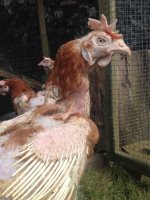You are using an out of date browser. It may not display this or other websites correctly.
You should upgrade or use an alternative browser.
You should upgrade or use an alternative browser.
Exbatts
- Thread starter rick
- Start date
valeriebutterley
New member
Poor girls,
Lovely to think though, in a few weeks, she will b a glorious little brown hen, and with the right treatment the most friendly amusing and friendly little girl.
I will never forget my two ex batts, funny, entertaining and so friendly, plus demon layers of enormous brown eggs. And much loved and spoiled rotten!!
Lovely to think though, in a few weeks, she will b a glorious little brown hen, and with the right treatment the most friendly amusing and friendly little girl.
I will never forget my two ex batts, funny, entertaining and so friendly, plus demon layers of enormous brown eggs. And much loved and spoiled rotten!!
dinosaw
New member
- Joined
- Aug 12, 2011
- Messages
- 1,659
- Reaction score
- 0
If the skin isn't red in the first place then there is no reason why it will be pecked Rick. Once it is pecked and becomes red or a feather is pulled and they get a taste for the blood it is then you get problems. One of our exbatts who we very originally called Baldy was almost a bad as this, she and all the others refeathered really well apart from the top of the wings at the shoulder where one bird used to continually peck them for some reason.
rick
Active member
I just find it rather remarkable and intriguing dinosaw. I'm wondering if they wear them down to shafts on the cage. I assumed they had pecked each other (or themselves) into that state but a lot of this hens downy under feathers are also intact. I guess it's a thing you have to see happening to know how it happens but that would be rather depressing!
Perhaps the poor feathering and consequent lack of normal insulation helps them to keep cool in the very hot and stuffy conditions of a commercial shed. Exbatts combs are usually much larger than normal, big and floppy, again to help them keep cooler, and gradually shrink and colour up when they get to a normal outdoor environment. We know that hens are much better at keeping warm in cold conditions than keeping cool when it's hot, so I expect they have to adapt if continually faced with overheated and overcrowded quarters, poor things. Also, maybe those kept in cages wear their feathers away from friction on the bars when they try to turn around?
Doesn't bear thinking about, does it.
Doesn't bear thinking about, does it.
rick
Active member
So maybe a case of all of the above and then once they've lost the feathers/barbs being better off without them given the circumstances.
It must be such a relief for the few that make it out to see grass and sunshine.
It must be such a relief for the few that make it out to see grass and sunshine.
But you're also right about the being disposed of when the flock goes into moult at around 18 months old. No farmer is going to feed them for up to 3-4 unproductive months in order to get less satisfactory eggs in their second laying season. So this must also account for the defeathering, especially in those birds who happen to be the first ones to drop what's left of their plumage.
chickenfan
Active member
- Joined
- Mar 9, 2013
- Messages
- 1,049
- Reaction score
- 0
I live near the main organic supplier of commercial hens to UK. She seems to think the brown hens are bred to have less feathers for economy, so less food goes into the feathering, but they do adapt to free ranging and grow more feathers. They struggle a bit in exposed sites like Dartmoor.
Latest posts
-
-
-
Topic Of The Week: Winter Egg Production: Challenges and Successes
- Latest: CherishedFowlGuardian
-
-
I recently lost my Lizzy. She couldn't walk for two years. I was her legs. Isn't she beautiful!
- Latest: CherishedFowlGuardian
-
-
-

